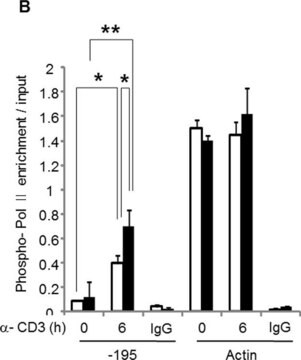05-952-I
Anti-RNA Polymerase II Antibody, CTD Antibody, clone 8WG16
clone 8WG16, from mouse
Synonim(y):
DNA-directed RNA polymerase II subunit RPB1, EC: 2.7.7.6, RNA polymerase II subunit B1, DNA-directed RNA polymerase II subunit A, DNA-directed RNA polymerase III largest subunit, RNA-directed RNA polymerase II subunit RPB1
About This Item
Polecane produkty
pochodzenie biologiczne
mouse
forma przeciwciała
purified immunoglobulin
rodzaj przeciwciała
primary antibodies
klon
8WG16, monoclonal
reaktywność gatunkowa
yeast, human
opakowanie
antibody small pack of 25 μg
metody
dot blot: suitable
immunoprecipitation (IP): suitable
inhibition assay: suitable
western blot: suitable
izotyp
IgG2aκ
numer dostępu NCBI
numer dostępu UniProt
docelowa modyfikacja potranslacyjna
unmodified
informacje o genach
human ... POLR2A(5430)
Opis ogólny
Specyficzność
Immunogen
Zastosowanie
Epigenetics & Nuclear Function
Dot Blot Analysis: A representative lot detected RNA Polymerase II, CTD in Dot Blot applications (Thompson, N.E., et. al. (1989). J Biol Chem. 264(19):11511-20).
Immunoprecipitation Analysis: A representative immunoprecipitated RNA Polymerase II, CTD in Immunoprecipitation applications (Bhaumik, S.R., et. al. (2001). Genes Dev. 15(15):1935-45).
Inhibition Analysis: A representative lot inhibited the interaction of RNA Polymerase II, CTD with the transcription complex. (Thompson, N.E., et. al. (1989). J Biol Chem. 264(19):11511-20).
Jakość
Western Blotting Analysis: 1 µg/mL of this antibody detected RNA Polymerase II, CTD in HeLa cell nuclear extract.
Opis wartości docelowych
Postać fizyczna
Przechowywanie i stabilność
Inne uwagi
Oświadczenie o zrzeczeniu się odpowiedzialności
Nie możesz znaleźć właściwego produktu?
Wypróbuj nasz Narzędzie selektora produktów.
Certyfikaty analizy (CoA)
Poszukaj Certyfikaty analizy (CoA), wpisując numer partii/serii produktów. Numery serii i partii można znaleźć na etykiecie produktu po słowach „seria” lub „partia”.
Masz już ten produkt?
Dokumenty związane z niedawno zakupionymi produktami zostały zamieszczone w Bibliotece dokumentów.
Nasz zespół naukowców ma doświadczenie we wszystkich obszarach badań, w tym w naukach przyrodniczych, materiałoznawstwie, syntezie chemicznej, chromatografii, analityce i wielu innych dziedzinach.
Skontaktuj się z zespołem ds. pomocy technicznej








